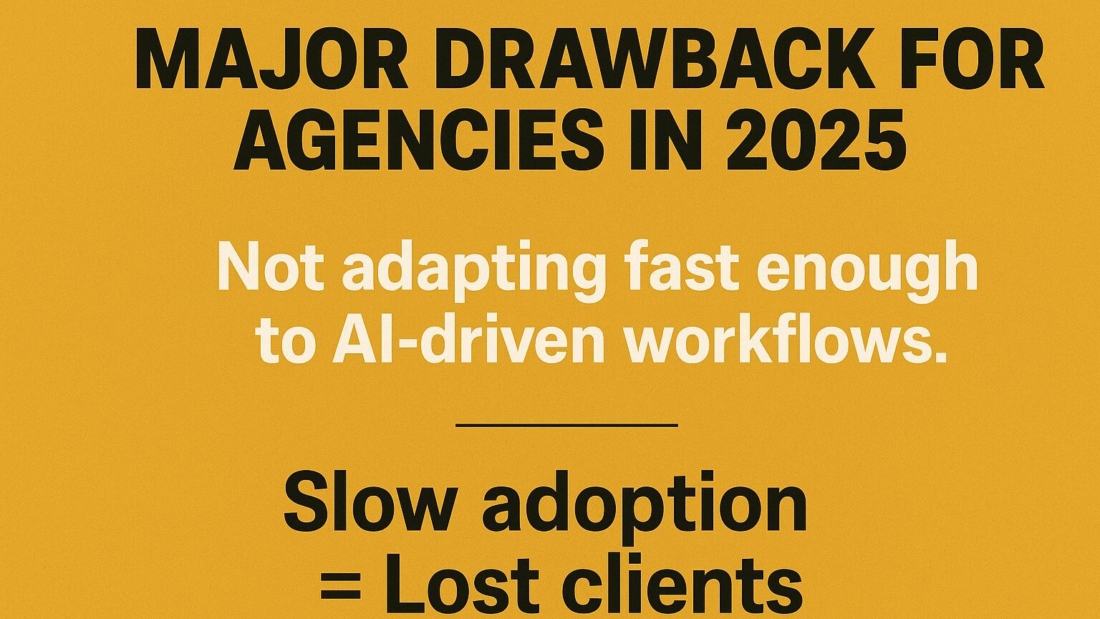The agency landscape has transformed dramatically in recent years. With digital marketing, creative production, and business operations evolving at lightning speed, one truth stands out in 2025: agencies that fail to adopt AI fast enough are falling behind. This slow adoption of AI-driven workflows has become the biggest drawback holding agencies back from scaling, innovating, and meeting client expectations.
Clients no longer want traditional solutions; they expect speed, accuracy, personalization, and data-driven results. As AI reshapes every industry, agencies resisting change risk losing market share, talent, and credibility.
Why Slow AI Adoption Is a Major Problem
1. Reduced Efficiency and Higher Costs
AI tools streamline repetitive tasks such as content creation, reporting, competitor analysis, and customer interaction. Agencies relying solely on manual workflows face:
- Delayed project delivery
- Higher operational costs
- More time spent on execution instead of strategy
When competitors are achieving in minutes what takes others hours or days, speed becomes a critical advantage.
2. Losing Clients to AI-Enabled Competitors
Businesses want modern solutions. Clients are increasingly informed and aware of AI. Agencies not using AI-powered strategies risk clients thinking:
“If they’re not using cutting-edge tools, how can they help us grow?”
In 2025, companies are actively choosing agencies that automate intelligently, deliver data-driven insights, and move quickly. Traditional work models simply cannot keep up.
3. Workforce Burnout and Talent Loss
Manual workloads lead to burnout. Talented professionals don’t want to work in outdated environments where they compete with inefficient systems instead of innovating. AI doesn’t replace teams—it enhances them.
Agencies that fail to integrate AI:
- Overwork their staff
- Struggle to retain skilled talent
- Slow down creative and strategic output
In contrast, AI-enabled teams stay motivated, productive, and creative.
4. Limited Innovation and Creative Potential
Some agency owners fear AI replacing creativity—but in reality, AI enhances it. It handles the groundwork, allowing creative minds to focus on big ideas, strategy, and customization.
Slow AI adoption results in:
- Stagnant ideas
- Limited experimentation
- Lack of innovative campaigns
In 2025, creativity must be technology-driven to stand out.
5. Falling Behind in Data-Driven Decision Making
AI transforms data into strategy in real time. Agencies without AI depend on time-consuming manual research and outdated insights.
This leads to:
- Poor targeting
- Weak performance reporting
- Slow reaction to market shifts
Data-driven marketing is the present and future—AI is the engine behind it.
How Agencies Can Avoid Falling Behind
✅ Invest in AI Tools Instead of Fearing Them
From content automation to CRM intelligence and design assistance, AI tools replace effort—not talent. Identify tasks AI can automate and start experimenting.
✅ Train Your Team
Upskill employees with AI courses, tools, and hands-on training. Teams who understand AI workflows outperform those trying to resist change.
✅ Integrate AI with Strategy
The real power isn’t using tools randomly—it’s building AI-powered systems and processes into agency operations.
✅ Be Transparent With Clients
Show clients how AI enhances creativity, accuracy, and efficiency. Make it your selling point.
✅ Stay Updated
Technology is evolving fast. Consistent learning and adaptation will keep agencies relevant and competitive.
Conclusion
The biggest drawback for agencies in 2025 is not competition, pricing, or changing platforms—it’s slow adoption of AI-driven workflows. Agencies clinging to old systems will lose clients, talent, and growth opportunities. Those embracing AI smartly will thrive, scale faster, and deliver unparalleled results.
The choice is simple:
Adapt and lead—or hesitate and fall behind.
Future-ready agencies are not waiting. They’re building AI-powered systems today.

